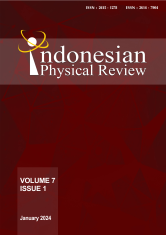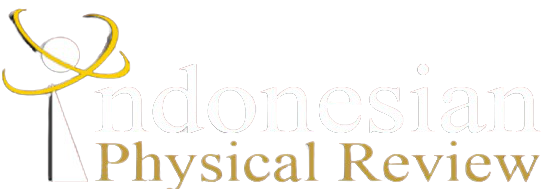THE EFFECT OF USING 4 POINTS LOCKS AND 9 POINTS LOCKS MASKS ON PATIENT SET-UP IN NASOPHARYNX CANCER
DOI:
10.29303/ipr.v7i1.229Downloads
Abstract
The set-up aims to find out the value of the shift that occurs while the patient is undergoing the irradiation process on the X-axis (right-left), Y-axis (caudal-cranial), and Z-axis (anterior-posterior). The procedure for collecting research data is by making direct observations and being involved in measuring set-up shifts. The data used amounted to 20 nasopharyngeal cancer patients. Set-up shift measurement data were taken sequentially from fractions 1-33 for each patient using 4 and 9 points locks masks. Analysis of statistical test data using SPSS version 25, to determine the effect of using 4 and 9 points locks masks on shifts in nasopharyngeal cancer irradiation set-up patients with fraction group: Group 1 (fraction 1), Group 2 (Fraction 2 – 15), Group 3 (16-33)  using the Wilcoxon test because the normality test results were not fulfilled. If the p-value ≤ 0.05, there is an effect of using 4 and 9 points locks mask on shifts, while for p-value ≥ 0.05, there is no effect of using 4 and 9 points locks mask on set-up shifts in nasopharyngeal cancer irradiation set-up. The results of the shift in the set-up of 4 and 9 points lock irradiation vertically in the lateral, longitudinal, and vertical directions tend to be positive (left, caudal, posterior). There was no effect of all fraction groups using 4 and 9 points locks on the shift in nasopharyngeal cancer irradiation set-up p-value> 0.05.
Keywords:
4 points locks mask 9 points locks mask patient set-up Nasopharynx cancerReferences
A. Handoko, E. Hidayanto, and dan Very Richardina, “Analisis keakuratan verifikasi dosis dengan menggunakan perbandingan phantom standar dan phantom replika,†Youngster Physics Journal, vol. 07, no. 1, pp. 1–10, 2018.
R. Elvira et al., “Analisis Perencanaan Radioterapi Pasien Kanker Nasofaring Menggunakan Teknik Intensity Modulated Radiotherapy,†Jurnal Fisika Unand (JFU), vol. 10, no. 3, pp. 337–343, 2021.
Jusmawang, S. Dewang, and B. Armynah, “Analisis Karakteristik Percentage Depth Dose (Pdd) Dan Profile Dose Pesawat Linear Accelerator (Linac) Untuk Berkas Sinar-X Dengan Variasi Luas Lapangan Penyinaran,†pp. 1–8, 2015.
S. Nofridianita, H. Prasetio, And S. A. Pawiro, “Perbandingan Verifikasi Akurasi Posisi Pasien Radioterapi Secara Manual dan Semiotomatis Berbasis Citra DRR/EPID,†Indonesian Journal of Cancer, vol. 10, no. 3, p. 103, 2016, doi: 10.33371/ijoc.v10i3.438.
E. D. Sigarlaki, M. Imanto, and E. Cania, “Tatalaksana Radioterapi pada Karsinoma Nasofaring,†Pengobatan Radioterapi pada Karsinoma Nasofaring Tatalaksana, vol. 8, no. 2, pp. 23–26, 2019.
Y. Yu, A. L. Michaud, R. Sreeraman, T. Liu, J. A. Purdy, and A. M. Chen, “Comparison of daily versus nondaily image-guided radiotherapy protocols for patients treated with intensity-modulated radiotherapy for head and neck cancer,†Head Neck, vol. 36, no. 7, pp. 992–997, 2014, doi: 10.1002/HED.23401.
B. H. Suharmono, I. Y. Anggraini, H. Hilmaniyya, and S. D. Astuti, “Quality Assurance (QA) Dan Quality Control (QC) Pada Instrumen Radioterapi Pesawat LINAC,†Jurnal Biosains Pascasarjana, vol. 22, no. 2, p. 73, 2020, doi: 10.20473/jbp.v22i2.2020.73-80.
I. Radiotherapy, “Safety Margins for Geometrical Uncertaintiesâ€.
A. J. Petrarizky and S. A. Gondhowiardjo, “Akurasi Geometri Pasien Yang Menjalani Radioterapi Stereotaktik Di Departemen Radioterapi RSCM,†vol. 6, no. 1, pp. 1–10, 2015.
K. N. Izza, L. Rusyadi, and J. Ardiyanto, “Verifikasi Geometri Pada Teknik 3d Konformal Radioterapi Dengan Kasus Kanker Nasofaring Di Unit Radioterapi Instalasi Radiologi Rsup dr. Sardjito Yogyakarta,†Jurnal Imejing Diagnostik (JImeD), vol. 4, no. 1, p. 35, 2018, doi: 10.31983/jimed.v4i1.3978.
H. Susworo, R. Kodrat, Dasar-Dasar Radioterapi Tatalaksana Radioterapi Penyakit kanker, Edisi II. 2017.
G. Li et al., “Migration from full-head mask to ‘open-face’ mask for immobilization of patients with head and neck cancer,†J Appl Clin Med Phys, vol. 14, no. 5, pp. 243–254, 2013, doi: 10.1120/jacmp.v14i5.4400.
C. G. Lin, S. K. Xu, W. Y. Yao, Y. Q. Wu, J. L. Fang, and V. W. C. Wu, “Comparison of set up accuracy among three common immobilisation systems for intensity modulated radiotherapy of nasopharyngeal carcinoma patients,†J Med Radiat Sci, vol. 64, no. 2, pp. 106–113, 2017, doi: 10.1002/jmrs.189.
“WWW.KLARITYMEDICAL.COMâ€.
C. R. Hansen, R. L. Christiansen, T. B. Nielsen, A. S. Bertelsen, J. Johansen, and C. Brink, “Comparison of three immobilisation systems for radiation therapy in head and neck cancer,†Acta Oncol (Madr), vol. 53, no. 3, pp. 423–427, 2014, doi: 10.3109/0284186X.2013.813966/SUPPL_FILE/IONC_A_813966_SM0001.PDF.
“Imaging for Radiation Therapy - Siemens Healthineers Indonesia.†https://www.siemens-healthineers.com/en-id/radiotherapy (accessed Jul. 28, 2023).
F. Adam and S. G. A., “Kanker Kepala dan Leher di Departemen Radioterapi RSCM,†Journal Research Gate, vol. 5, no. 1, pp. 1–8, 2014.
E. Anderson, K. Pilling, S. Iqbal, and R. L. Pearson, “A retrospective analysis comparing set up errors from standard versus customised headrests for head and neck radiotherapy,†Radiography, vol. 28, no. 3, pp. 746–750, 2022, doi: 10.1016/j.radi.2022.03.008.
J. Jia, G. Xu, X. Pei, R. Cao, L. Hu, and Y. Wu, “Accuracy and efficiency of an infrared based positioning and tracking system for patient set-up and monitoring in image guided radiotherapy,†Infrared Phys Technol, vol. 69, pp. 26–31, 2015, doi: 10.1016/j.infrared.2015.01.001.
License

This work is licensed under a Creative Commons Attribution-NonCommercial-ShareAlike 4.0 International License.
Authors who publish with Indonesian Physical Review Journal, agree to the following terms:
- Authors retain copyright and grant the journal right of first publication with the work simultaneously licensed under a Creative Commons Attribution-ShareAlike 4.0 International Licence (CC BY SA-4.0). This license allows authors to use all articles, data sets, graphics, and appendices in data mining applications, search engines, web sites, blogs, and other platforms by providing an appropriate reference. The journal allows the author(s) to hold the copyright without restrictions and will retain publishing rights without restrictions.
- Authors are able to enter into separate, additional contractual arrangements for the non-exclusive distribution of the journal's published version of the work (e.g., post it to an institutional repository or publish it in a book), with an acknowledgment of its initial publication in Indonesian Physical Review Journal.
- Authors are permitted and encouraged to post their work online (e.g., in institutional repositories or on their website) prior to and during the submission process, as it can lead to productive exchanges, as well as earlier and greater citation of published work (See The Effect of Open Access).





